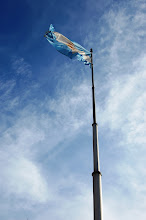I’ve gotten several questions about long-distance buses that I’m going to try and answer here. First, seats (butacas). I realize that Plataforma10 gives you lots of options, especially if you’re heading to a fairly common destination, like Córdoba, Salta, Rosario, or Mar del Plata. The seat names can be confusing, mainly because they are all so similar and also because they are amazingly non-descriptive—I mean, semi-cama? How semi is semi?! Let’s explore.
In general, Semi-cama seats are the least-reclining of all seats, usually tilting back to a 120 degree angle. Cama is the next step up, with seats that recline to about 140 degrees. Cama Suite, Coche Suite, or just Suite usually means 180 degrees of sweet, sweet recline, aka completely horizontal. These seats are often a bit wider than the other kinds and there’s more space between each seat. Seats with Plus or Super in the name are also usually 180 degree seats. Cama VIP, Cama Ejecutivo or just Ejecutivo seats are tricky—it depends on the bus company, but they are usually between 160 and 180 degree recline. If it says c/ servicio after the seat name, that means you get food. However, if doesn’t say c/servicio, it doesn’t necessarily mean that you don’t get food.
Since my descriptions are about as useful as tits on a snake, you can also use Plataforma10 itself (no, I don’t know where that expression comes from but it’s compelling, no?) When you search for a particular destination and date, the bus company will be on the far left side of the list that comes up. Click on it and you will be taken to a page that describes the different seat types--with degrees of recline--and service options that the company provides (comodidades según servicio de omnibus). It will also list all the principal cities the company hits on its routes. (Note: if the page shows up with no information on it, as it might occasionally, then you can just type the name of the company into Google and look up the Servicios section on their website.)
Of course, the Plataforma10 information is in Spanish which is pretty unhelpful if you don’t speak Spanish. Here are some of the more common terms you will find:
Butaca- seat
Bandeja de apoyo or apoya piernas- foot/leg rest
Mantas y almohadas- blankets and pillows
Desayuno- breakfast
Cena- dinner
Aire accondicionado y calefacción- heating and AC
Servicio a bordo- on-board service (entrada fría, cena caliente, desayuno = cold appetizer, hot main dish, breakfast)
Luces de lectura- Reading lights
Separador y cortina entre butacas- curtain between seats for privacy
Películas- movies
Café, agua, vinos, gaseosas- coffee, water, wine, sodas
Minibar- no translation required :)
No matter which bus you choose, there will always be a bathroom available, and there will always be a water cooler near the front if you get thirsty. Almost all buses have leg or foot rests for each seat, and curtains on the windows. If you are going on a long trip, they will feed you or you will be able to get off at certain stops and buy food. Even on shorter trips, the company will often leave a little box or bag of standard Argentine snacks, aka alfajores and crackers. They aren’t going to leave you high and dry on a long trip, but if you’re worried about food or drink, you can always bring your own!
Tuesday, February 23, 2010
Subscribe to:
Post Comments (Atom)


Thanks, you're a star. According to the great book Che Boludo, your compelling phrase is as follows in castellano: 'al pedo como teta de monja' - 'as useless as tits on a nun'
ReplyDeleteif someone is planning a trip to mar del plata, the best company bus is "TONY TUR".
ReplyDeleteAnd the plataforma number is a problem for us who speak spanish too, (one time i missed my bus because i could't find it...really.. and i'm always early).